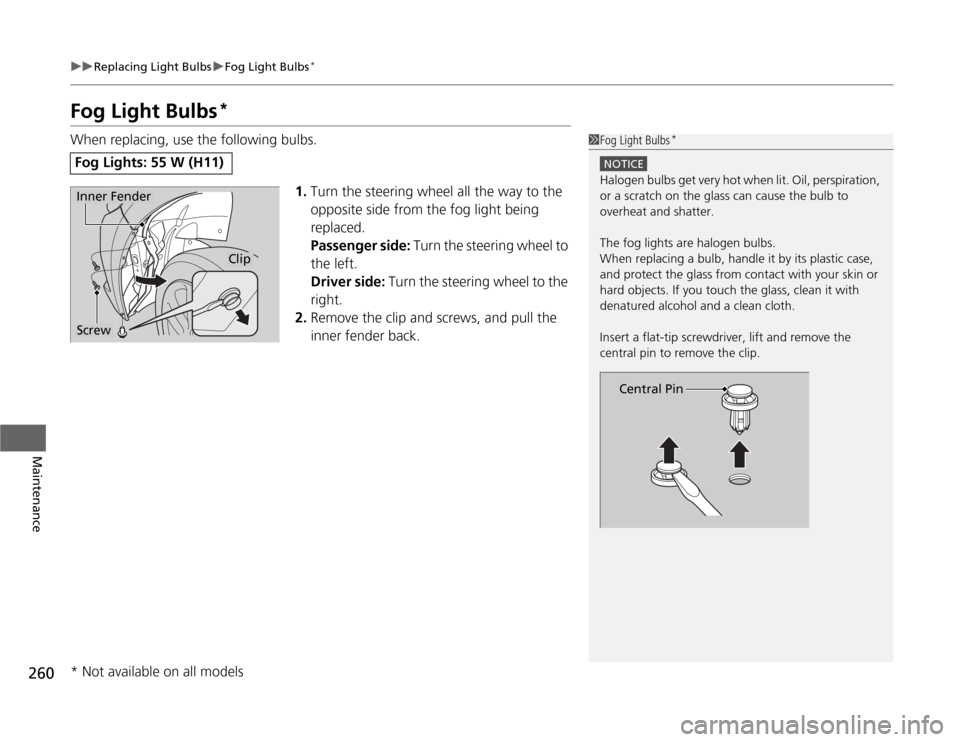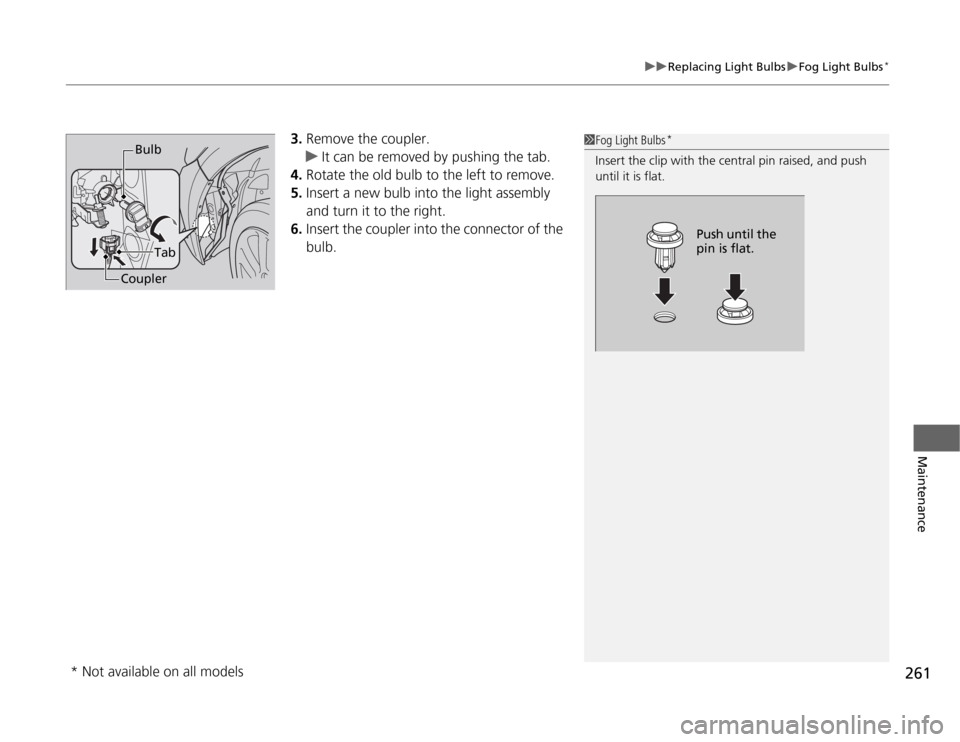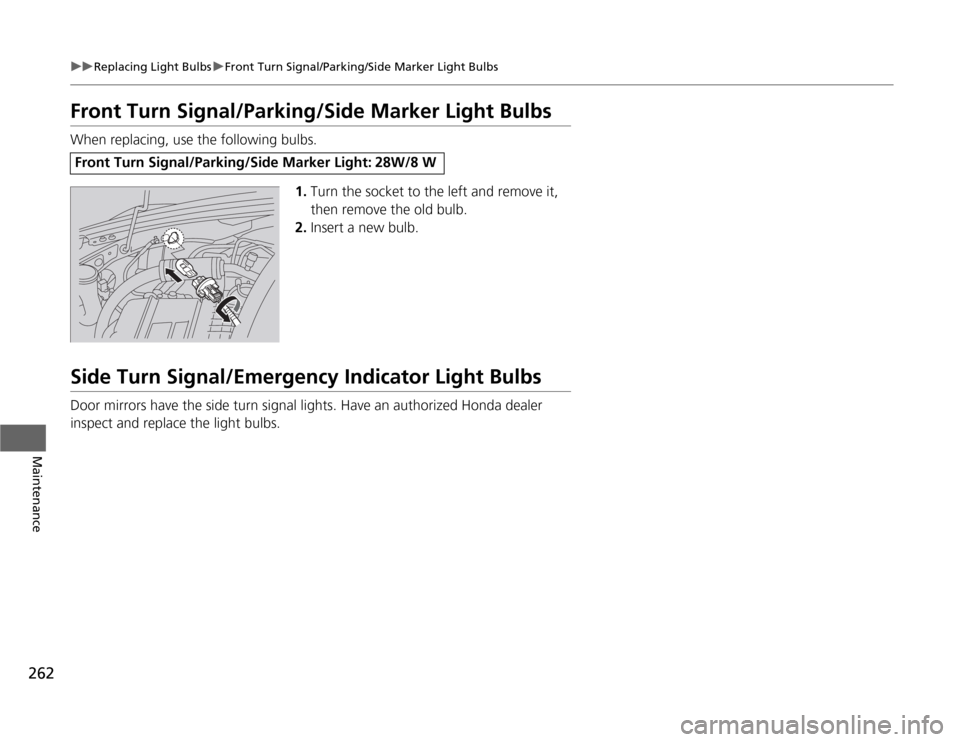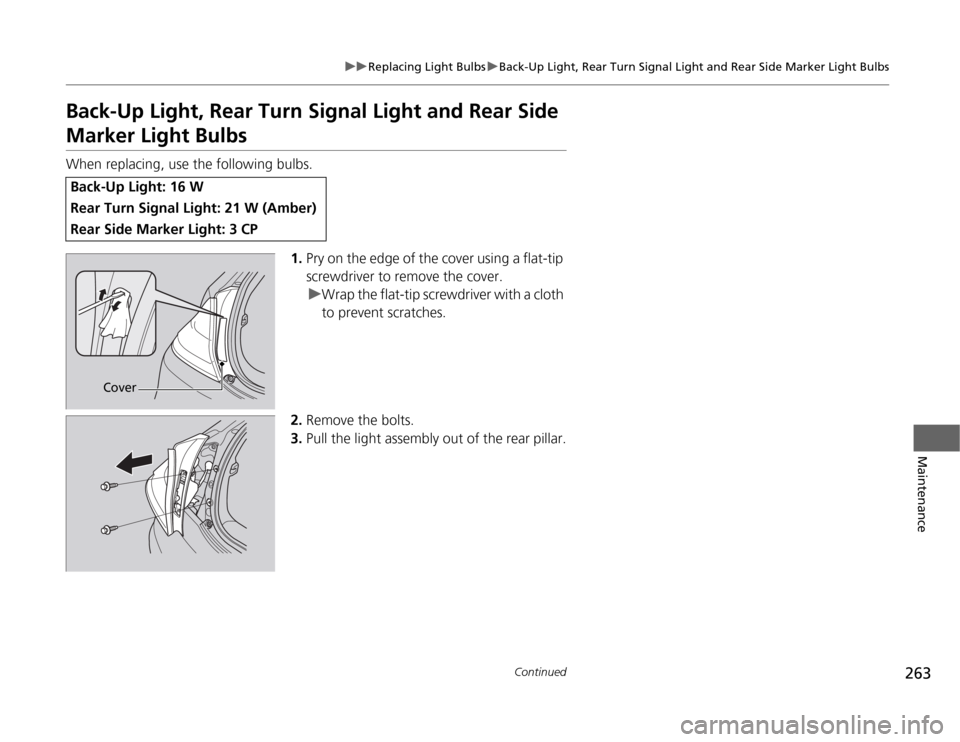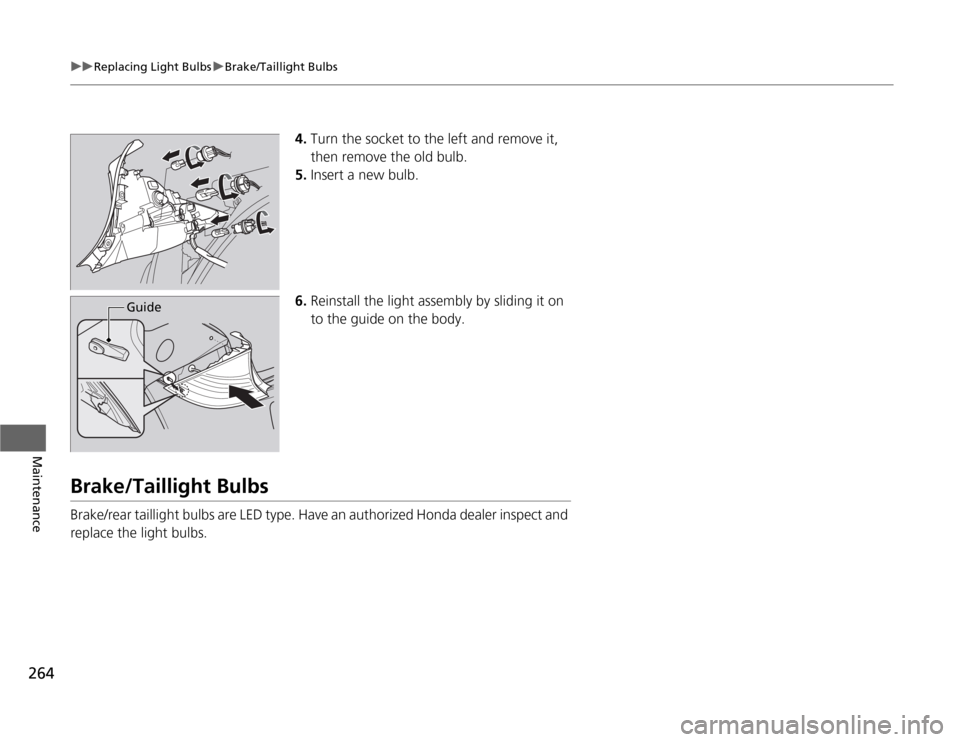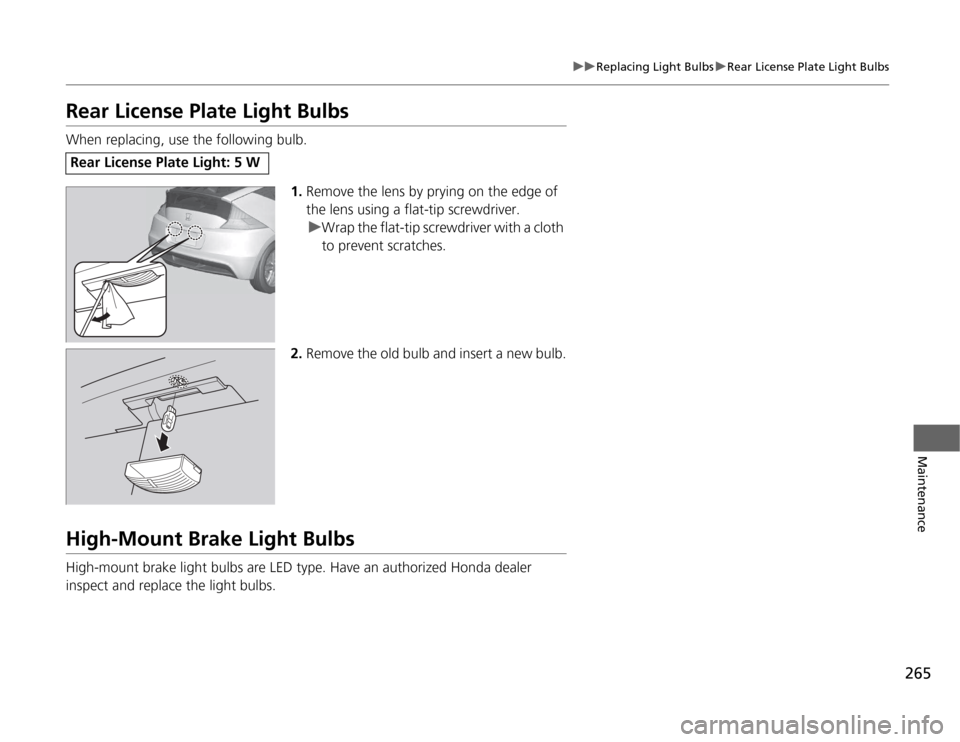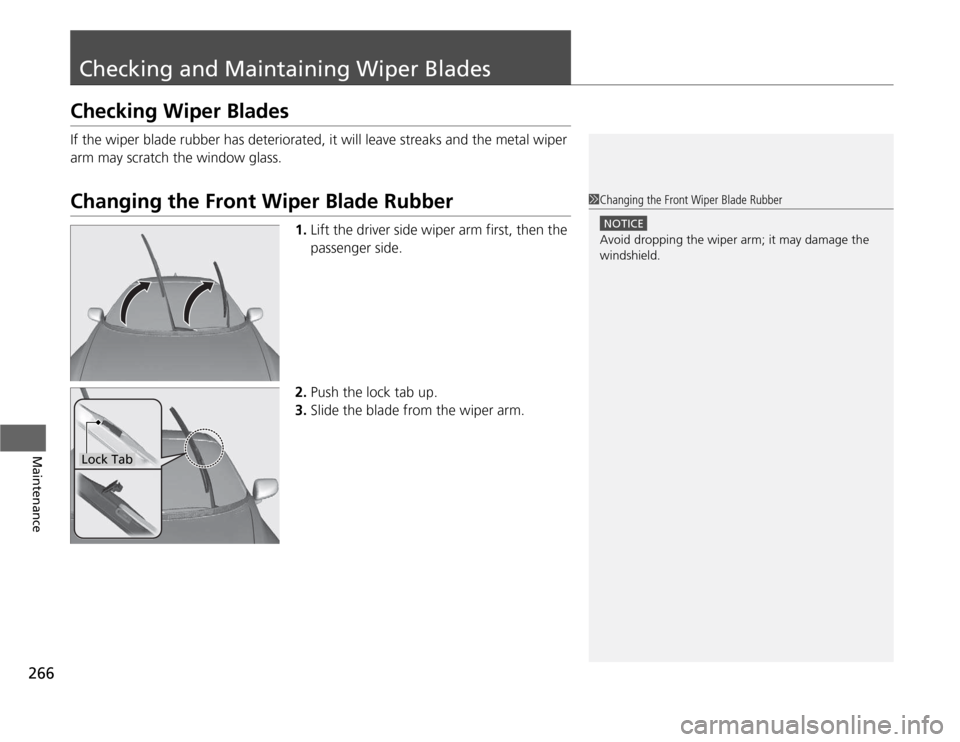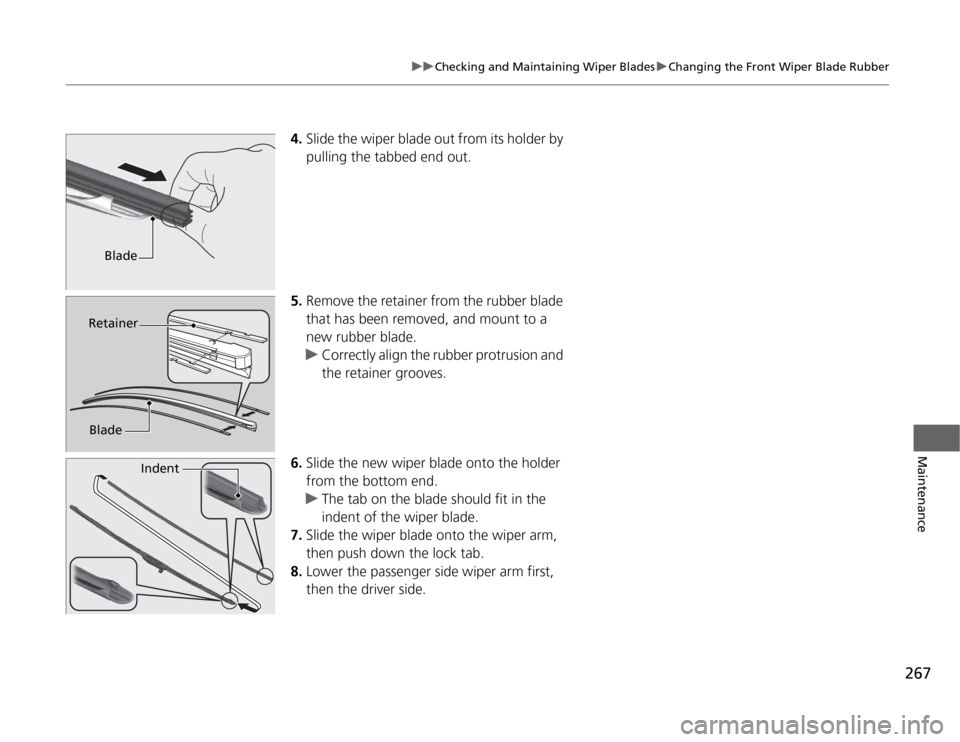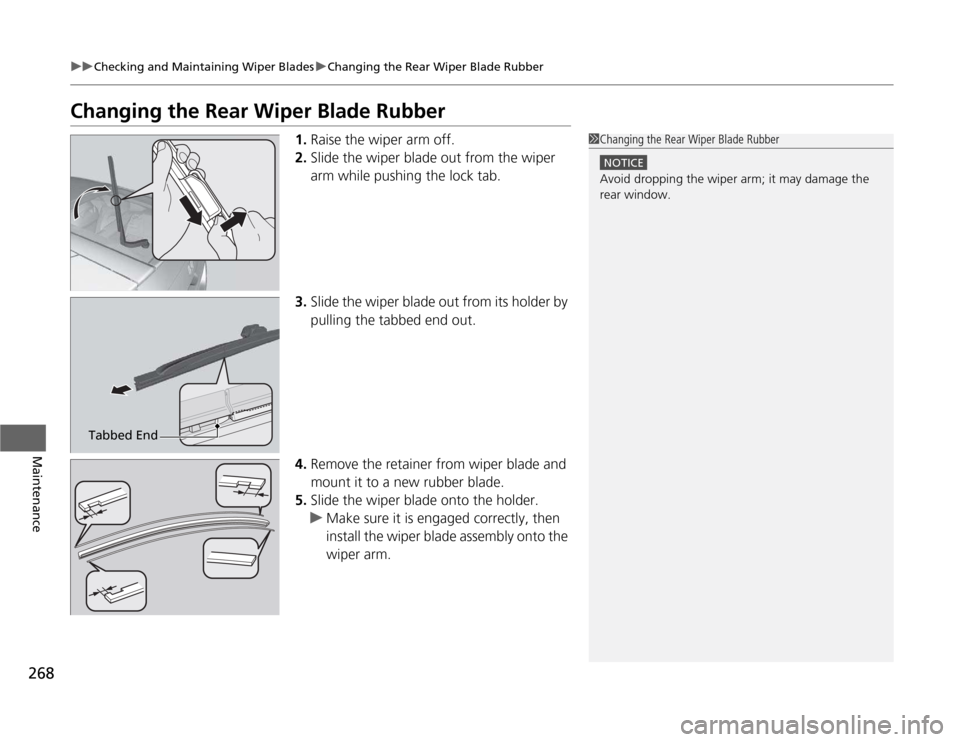HONDA CR-Z 2012 1.G Owners Manual
CR-Z 2012 1.G
HONDA
HONDA
https://www.carmanualsonline.info/img/13/5810/w960_5810-0.png
HONDA CR-Z 2012 1.G Owners Manual
Trending: child restraint, automatic transmission fluid, clock setting, towing capacity, jump cable, clock, fuel filter location
Page 261 of 333
260
uuReplacing Light BulbsuFog Light Bulbs*
Maintenance
Fog Light Bulbs *
When replacing, use the following bulbs.
1.Turn the steering wheel all the way to the
opposite side from the fog light being
replaced.
Passenger side: Turn the steering wheel to
the left.
Driver side: Turn the steering wheel to the
right.
2. Remove the clip and screws, and pull the
inner fender back.
Fog Lights: 55 W (H11)
1Fog Light Bulbs *
NOTICE
Halogen bulbs get very hot when li
t. Oil, perspiration,
or a scratch on the glass can cause the bulb to
overheat and shatter.
The fog lights are halogen bulbs.
When replacing a bulb, handle it by its plastic case,
and protect the glass from contact with your skin or
hard objects. If you touch the glass, clean it with
denatured alcohol and a clean cloth.
Insert a flat-tip screwdri ver, lift and remove the
central pin to remove the clip.
Central Pin
Inner Fender
Screw
Clip
* Not available on all models
Page 262 of 333
261
uuReplacing Light BulbsuFog Light Bulbs*
Maintenance
3.
Remove the coupler.
uIt can be removed by pushing the tab.
4. Rotate the old bulb to the left to remove.
5. Insert a new bulb into the light assembly
and turn it to the right.
6. Insert the coupler into the connector of the
bulb.
1Fog Light Bulbs *
Insert the clip wi th the central pin raised, and push
until it is flat.
Push until the
pin is flat.
Bulb
Tab
Coupler
* Not available on all models
Page 263 of 333
262
uuReplacing Light BulbsuFront Turn Signal/Parking/Side Marker Light Bulbs
Maintenance
Front Turn Signal/Parking/Side Marker Light Bulbs
When replacing, use the following bulbs.1.Turn the socket to the left and remove it,
then remove the old bulb.
2. Insert a new bulb.
Side Turn Signal/Emergency Indicator Light Bulbs
Door mirrors have the side turn signal lights. Have an authorized Honda dealer
inspect and replace the light bulbs.
Front Turn Signal/Parking/Side Marker Light: 28W/8 W
Page 264 of 333
263
uuReplacing Light BulbsuBack-Up Light, Rear Turn Signal Light and Rear Side Marker Light Bulbs
Continued
Maintenance
Back-Up Light, Rear Turn Signal Light and Rear Side
Marker Light Bulbs
When replacing, use the following bulbs.1.Pry on the edge of the cover using a flat-tip
screwdriver to remove the cover.
uWrap the flat-tip screwdriver with a cloth to prevent scratches.
2. Remove the bolts.
3. Pull the light assembly out of the rear pillar.
Back-Up Light: 16 W
Rear Turn Signal Light: 21 W (Amber)
Rear Side Marker Light: 3 CP
Cover
Page 265 of 333
264
uuReplacing Light BulbsuBrake/Taillight Bulbs
Maintenance
4.Turn the socket to the left and remove it,
then remove the old bulb.
5. Insert a new bulb.
6. Reinstall the light assem bly by sliding it on
to the guide on the body.
Brake/Taillight Bulbs
Brake/rear taillight bulbs are LED type. Have an authorized Honda dealer inspect and
replace the light bulbs.
Guide
Page 266 of 333
265
uuReplacing Light BulbsuRear License Plate Light Bulbs
Maintenance
Rear License Plate Light Bulbs
When replacing, use the following bulb.1.Remove the lens by prying on the edge of
the lens using a flat-tip screwdriver.
uWrap the flat-tip screwdriver with a cloth to prevent scratches.
2. Remove the old bulb and insert a new bulb.
High-Mount Brake Light Bulbs
High-mount brake light bulbs are LED type. Have an authorized Honda dealer
inspect and replace the light bulbs.
Rear License Plate Light: 5 W
Page 267 of 333
266
Maintenance
Checking and Maintaining Wiper Blades
Checking Wiper Blades
If the wiper blade rubber has deteriorated, it will leave streaks and the metal wiper
arm may scratch the window glass.
Changing the Front Wiper Blade Rubber1.Lift the driver side wiper arm first, then the
passenger side.
2. Push the lock tab up.
3. Slide the blade from the wiper arm.1Changing the Front Wiper Blade Rubber
NOTICE
Avoid dropping the wiper arm; it may damage the windshield.
Lock Tab
Page 268 of 333
267
uuChecking and Maintaining Wiper BladesuChanging the Front Wiper Blade Rubber
Maintenance
4.Slide the wiper blade out from its holder by
pulling the tabbed end out.
5. Remove the retainer from the rubber blade that has been removed, and mount to a
new rubber blade.
uCorrectly align the rubber protrusion and
the retainer grooves.
6. Slide the new wiper blade onto the holder from the bottom end.
uThe tab on the blade should fit in the
indent of the wiper blade.
7. Slide the wiper blade onto the wiper arm,
then push down the lock tab.
8. Lower the passenger side wiper arm first,
then the driver side.
Blade
Retainer
Blade
Indent
Page 269 of 333
268
uuChecking and Maintaining Wiper BladesuChanging the Rear Wiper Blade Rubber
Maintenance
Changing the Rear Wiper Blade Rubber1.Raise the wiper arm off.
2. Slide the wiper blade out from the wiper
arm while pushing the lock tab.
3. Slide the wiper blade out from its holder by
pulling the tabbed end out.
4. Remove the retainer from wiper blade and
mount it to a new rubber blade.
5. Slide the wiper blade onto the holder.
uMake sure it is engaged correctly, then
install the wiper blade assembly onto the
wiper arm.
1Changing the Rear Wiper Blade Rubber
NOTICE
Avoid dropping the wiper arm; it may damage the rear window.
Tabbed End
Page 270 of 333
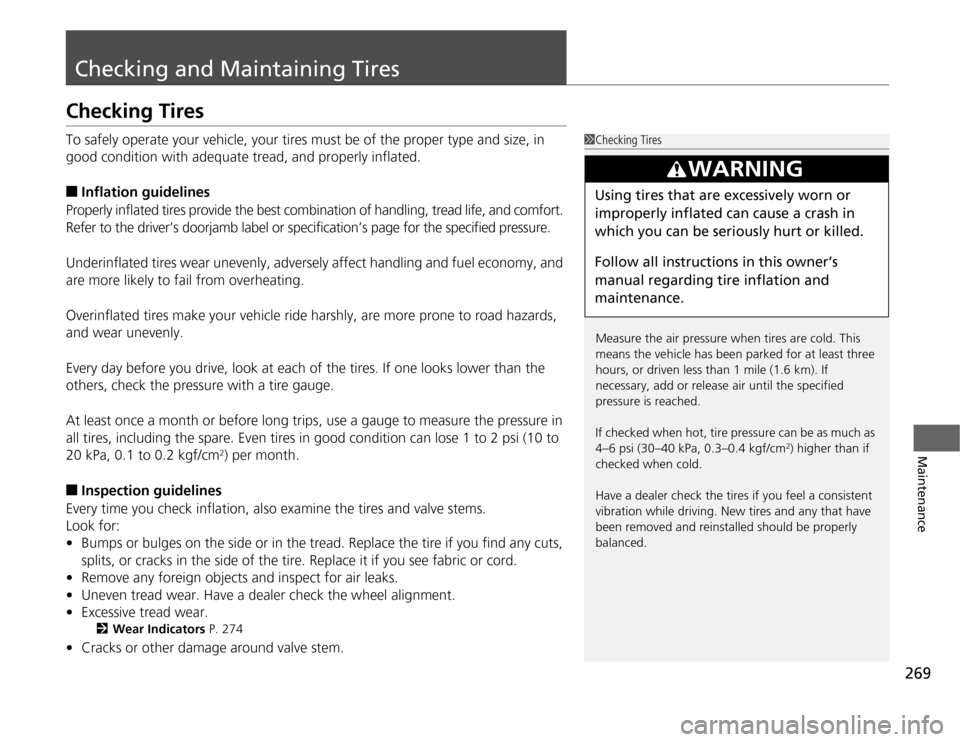
269
Maintenance
Checking and Maintaining Tires
Checking Tires
To safely operate your vehicle, your tires must be of the proper type and size, in
good condition with adequate tread, and properly inflated. ■Inflation guidelines
Properly inflated tires provide the best co mbination of handling, tread life, and comfort.
Refer to the driver’s doorjamb label or specification’s page for the specified pressure.
Underinflated tires wear unevenly, adversely affect handling and fuel economy, and
are more likely to fail from overheating.
Overinflated tires make your vehicle ride harshly, are more prone to road hazards, and wear unevenly.
Every day before you drive, look at each of the tires. If one looks lower than the
others, check the pressure with a tire gauge.
At least once a month or before long trips, use a gauge to measure the pressure in
all tires, including the spare. Even tires in good condition can lose 1 to 2 psi (10 to
20 kPa, 0.1 to 0.2 kgf/cm 2
) per month.
■ Inspection guidelines
Every time you check inflation, also examine the tires and valve stems.Look for:• Bumps or bulges on the side or in the tread. Replace the tire if you find any cuts,
splits, or cracks in the side of the tire. Replace it if you see fabric or cord.
• Remove any foreign objects and inspect for air leaks.
• Uneven tread wear. Have a dealer check the wheel alignment.
• Excessive tread wear.
2 Wear Indicators P. 274
• Cracks or other damage around valve stem.
1Checking Tires
Measure the air pressure when tires are cold. This
means the vehicle has been par ked for at least three
hours, or driven less than 1 mile (1.6 km). If
necessary, add or release air until the specified pressure is reached.
If checked when hot, tire pressure can be as much as
4–6 psi (30–40 kPa, 0.3–0.4 kgf/cm 2
) higher than if
checked when cold.
Have a dealer check the tires if you feel a consistent
vibration while driving. New tires and any that have
been removed and reinstalled should be properly balanced.
3WARNING
Using tires that are excessively worn or
improperly inflated can cause a crash in
which you can be seri ously hurt or killed.
Follow all instruc tions in this owner’s
manual regarding tire inflation and
maintenance.
Trending: inflation pressure, audio, clock setting, air conditioning, deactivate passenger airbag, coolant level, fuel tank capacity
